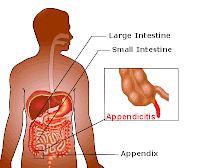What is an ACUTE APENDICITIS?
 |
| Acute Apendicitis |
It is always a common sight in the ER to see a number of clients who are rushing in into the room and complain of abdominal pain. Moreover, that abdominal pain doesn’t immediately equate to just one medical condition where the clinician could treat the client right away. An acute abdomen can be indicative of a wide array of gastrointestinal conditions but with the help of modern diagnostic tools clinicians are able to pinpoint the problem more conveniently and most commonly among others the pain can be a result of an acute appendicitis.






